
Angus and Rosemary's Miscellany
of Malvern - Local History
|
History menu > Public utilities then and now
Nowadays we take these services for granted, but in the 1950s most homes did not have central heating; most homes did not have telephones and those that did were served by a slow manual exchange. Some farm workers' cottages did not have piped water, gas or electricity, relying on water from a well or pump and an iron range burning wood or coal for heating and cooking. Lighting in cottages without electricity and gas would have been provided by a paraffin lamp and probably a candle taken to bed. Discoveries and inventions by scientists and engineers are improved upon over time and the take-up by the public has depended on both supply and demand as well as effectiveness, practicality, the availability of materials, and especially affordability, sometimes leading to many years between an invention and its common appearance in the home. What follows is a short history, mainly written for younger people, explaining how these services evolved locally. ContentsAs this is a long page here are some bookmarks to take you to the section you are most interested in. Post, Telegraphy, Teleprinters, Telephones and the Internet > Data communications and the Internet Examples of early telephone numbers References and books about Malvern The water supply
'Run off' of rainwater from The Malvern Hills appearing as 'springs' was sufficient to support the small local population, of a few hundred families, in ancient times, though some of the springs could dry up in long periods of summer drought. The development of the Water Cure in the 1800s led both to a large increase in the population and high demand from the Water Cure establishments. A Parliamentary Act of 1851 set in train the town council and plans to improve the water supply. This led to water from the springs being diverted into large collection tanks. Surprisingly, the precious water was partly used to dampen the roads to reduce dust - no tarmac in those days! Linked to the story of the water supply is the name of Dr William Bennett Garlike of Melton House or Lodge, Wells Road, whose daughter Mary is buried in Guarlford churchyard. Melton occupied about three acres of land between Abbey Road and the Wells Road, with approximately 400 ft fronting Abbey Road and 300 ft fronting the Wells Road (see photo of modern house below). 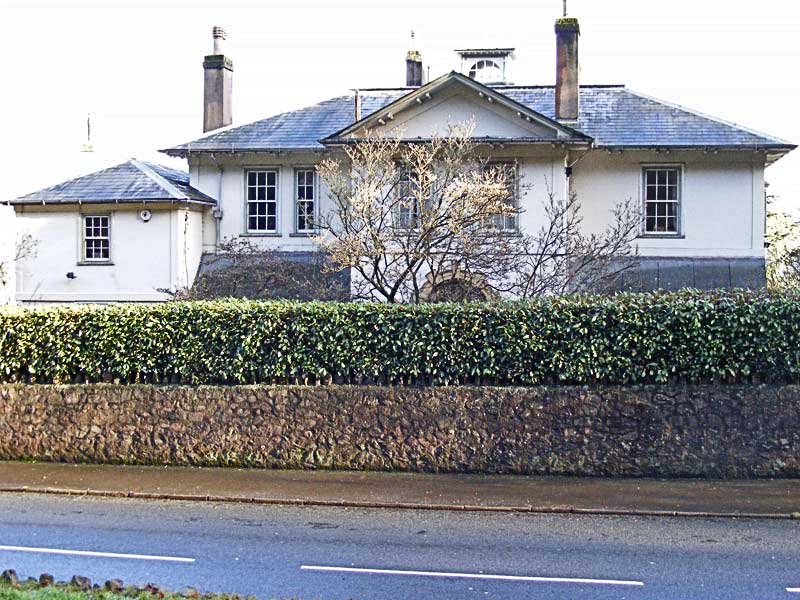
Melton House Melton's water supply came from a heading driven into the sandstone above the house. Dr Garlike, who had moved to Great Malvern from Marlborough, is said to have acted as physician to the Duchess of Kent and Princess Victoria when they visited Malvern in 1830. About 1828 Dr Garlike had the water piped under the Wells Road and into a tank in his garden. The spring was prolific and was one of three sources that fed a water-mill near Poolbrook. More about this can be found in Aqua Malvernensis. About 1850, as a consequence of the diversion of the springs to a reservoir, the flow of water to Poolbrook and Guarlford was greatly reduced and the water-mill in Mill Lane had to close. Page 10 of The Guarlford Story describes the effect of this diversion of water on the village, which even led to a legal battle. Between 1851 and 1894 various schemes were undertaken but demand for water continued to outstrip supply; then in 1894 a reservoir was opened at British Camp. For a period that met demand, until even more water was required,and then additional water was pumped up to the reservoir from boreholes sunk at Bromsberrow in 1906. Elderly villagers in Guarlford described the wells and hand-pumps used until after World War Two. One said that you had to look in the bucket before you drank the water and swish it round with your hand to see what was in it! (Source: The Guarlford Story) Water authorities amalgamated until in 1989 the water industry was privatised by the Thatcher government, and Malvern became part of the Severn Trent (ST) water network. 'Two thirds of Severn Trent water now comes from rivers and reservoirs, which drain moorland, farmland and urban areas before reaching surface water treatment works. Other water comes from boreholes. The Severn Trent strategic grid extends from the Peak District in the north, encompassing most of Derbyshire and Leicestershire then southwest through Warwickshire to Gloucester, and north-west covering most of Worcestershire and some of Shropshire. The strategic grid is made up of 14 major water treatment works, five reservoir complexes, three major grid booster pumping stations and a number of strategic pipeline network connections and aqueducts'.(source: ST website), Nowadays we don't know exactly where Malvern's tap-water comes from, but we do know the supply is reliable and tested to be free of harmful impurities. Other poorer countries are not so lucky. Looking to the future, county planners in 2012 have in mind 1,500 new homes to be built in Malvern during the next 20 or so years, which possibly might once more place a strain on supplies. GasBeginnings
The process for the extraction of coal gas from coal, and practical gas lighting was first demonstrated circa 1800 at the Soho Foundry. Another pioneer was Frederick Winsor who founded the Gas, Light and Coke Company. Although coal gas was invented circa 1800 it was not until 1856 that Malvern town council opened a gasworks in Pickersleigh Road, for lighting the streets of Great Malvern. Malvern was once well known for its gas lamps and it is said the gas lamps inspired CS Lewis when he wrote 'The Lion, the Witch, and the Wardrobe'. Coal gas was produced by heating coal and evaporating off the volatile content. The residue, coke, was more difficult to ignite but could be burnt as smokeless fuel. Another important residue was tar. The Lower Howsell gasworksA second gasworks was opened in 1861 at Lower Howsell Malvern Link next to the railway line where there was a siding to bring in coal. Alan Hodges remembers the Lower Howsell gasworks which he regularly passed on his way to school in Worcester in the 1950s. To quote (ref 16):
We assume the Lower Howsell gasworks was demolished in the 1980s, leaving a compound which has lately been used by gas contractors. Blackmore Park mansionBlackmore Park, a country mansion near Hanley Swan was gutted by a fire in 1880, Restored in 1883 it had a private gas supply used for lighting. George Bedington's father John would walk from Hall Green, Malvern, over Wood Street to Blackmore each day to check the compressor. Blackmore Park was owned by the Hornyold family until the male line expired, when a nephew whose surname was Gandolfi inherited the estate. In 1926 the house was sold to a developer. Shortly after a mysterious fire gutted the house and the shell was demolished; all that remained was the portico which was re-erected at Malvern Girls College (ref 7). Metering and gas mantlesUp until 1880 town gas used in homes for lighting was charged by duration and monitored by a warden in the street. Then coin operated penny meters were introduced. Only a dim light was obtained from the naked yellow flame of early gas lamps, until about 1900 when the gas mantle was invented. The mantle was a fine mesh of fibres which, when heated to white heat using a burner based on the invention by Robert Bunsen, enabled a bright light to be produced. The gas mantles were made using a coating of radioactive Thorium which was not good for the health of the girls making them. Likewise the lives of stokers in the gasworks were greatly shortened by breathing the fumes from the burning coal. Later as production of gas increased it was also used for heating. Water GasAnother invention was Water Gas created by passing water vapour over burning coal, producing hydrogen and poisonous carbon monoxide. The industrialist Samson Fox launched a company to promote the use of water gas but it was not then a commercial success and the investors lost money. (It is less well known that Samuel Fox, ancestor of the Fox acting dynasty, donated all, or nearly all, the funds required to build the Royal College of Music.) Nationalisation and natural gasAfter WWII the gas industry was nationalised. In the 1960s Natural Gas began to be imported from North Sea Oilfields and a national underground pipeline was built, fanning out from Scotland where the gas was brought ashore. The gas had to be forced down the pipeline network by gas turbines. Coal gas production gradually ceased and gasworks and gasometers were demolished and replaced by homes and supermarkets. New gas jets had to be fitted to gas appliances such as kitchen cookers, boilers and gas fires, as the new fuel had a higher calorific value than the old. PrivatisationThe gas industry was privatised by Margaret Thatcher's government in 1986 Margaret Thatcher took the view that natural gas was a premium product that should generally be reserved for use in the home. However, following privatisation of the Electricity industry in 1990 power generators found that gas fired power stations were cheaper to build and easier to switch on and off. Consumption of gas for electricity generation has meant that natural gas has run out sooner than it might otherwise have done, and expensive LPG is now being imported from overseas into Milford Haven. So now a new pipeline network for these supplies, fanning out from Wales to Scotland, could be required, replacing the dwindling supply from the North Sea. After the Pickersleigh Road gasworks was demolished in the 1970s the site was used as a council depot, until replaced by the new Prospect View medical centre and housing. The Gas Tavern opposite was demolished in 2010 and has been replaced by a small Tesco store. Green HydrogenConcerns about climate change aggravated by burning fossil fuels are causing governments to reduce the burning of coal, oil and natural gas, and greatly increase the use of electric vehicles, particularly in cities. Hydrogen gas is seen as a possible alternative fuel. 'Green' Hydrogen can be produced by electrolysis of water using electricity from renewable sources such as wind, solar, and hydro. Hydrogen gas can be thought of as a battery for storing electrical energy for later use. Whether or not this process will become economic we don't know but there must be opportunities for budding industrial chemists and process engineers to research the viability and, if appropriate, develop plant for the production of affordable Green Hydrogen. 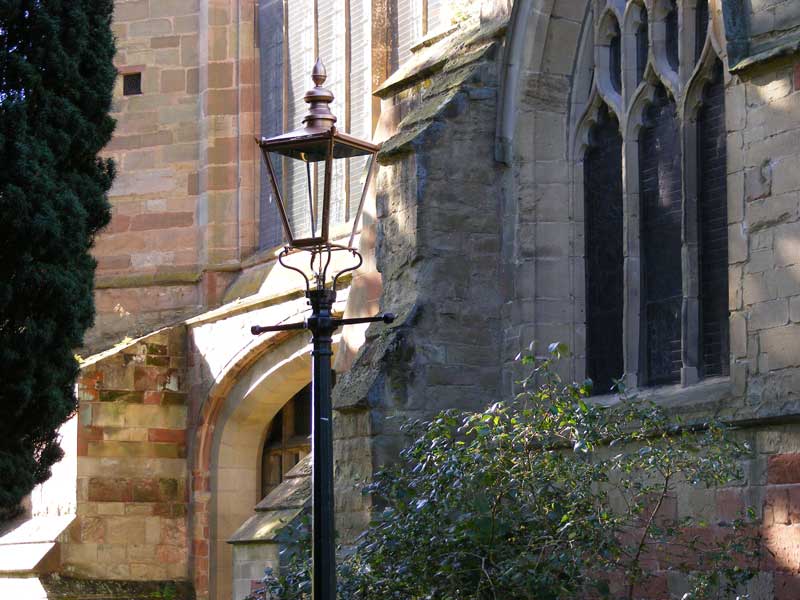
Gas lamp at east end of the Priory Electricity
The first commercially practical electric incandescent light was invented by Thomas Edison about 1879. By 1906 improved coiled coil filaments were in production. Locally the first power station was at Powick Mill, near Worcester, where a water and steam powered generator was installed to provide electricity to light the town of Worcester in 1894. It closed in the 1950s. In Malvern the Urban District Council built an Electric Light Works alongside the gasworks in Pickersleigh Road, which opened in 1904. The Priory church in Great Malvern was lit by electricity in 1906. Competition between British companies resulted in fragmentation of the electricity supply industry and it took action by the British government to establish the National Grid, which began to take shape in the 1930s. It all goes to show that the private sector alone cannot always be relied upon to do what is best for the country. Some remote country houses generated their own electricity for lighting from motor driven generators, while some cottages on the outskirts of Malvern did not receive electricity until the 1950s. Early wiring comprised twin rubber flex enclosed in a lead sheath. You may still come across this if you are renovating a pre WWII house or outbuilding that has not been occupied for years, but this should all have been replaced as the rubber will have perished many years ago. In the 1950s there were large round pin brown 15 amp bakelite plugs for electric fires, smaller five amp plugs for irons and two amp plugs for small appliances such as radios, table lamps and vacuum cleaners. Houses built after about 1948 used the modern 13 amp plug with a fuse to suit the appliance. These are still better than many smaller but fragile plugs used abroad. Electricity entered the home via a fuse box with a master lever operated on/off switch. Fuses using fuse-wire were installed up until the 1970s. Fuse boxes have been replaced by a consumer unit incorporating a Residual Current Circuit Breaker (RCCD) protecting against electric shock and Miniature Circuit Breakers (MCBs) which can be reset without having to replace fuse wire. Very occasionally plastic consumer units have caugh fire, so there has been talk of a return to steel. In the 1960s the electricity generating industry was struggling to meet the challenge of increasing demand for electricity. Then power stations were mainly coal fired but a balance between oil, coal and atomic power was envisaged so as not to be dependant on any one fuel. Newspapers predicted atomic power would reduce the cost of electricity to a fraction of a penny - say 2 pence in today's inflated decimalised currency - compare that with a price of about 15 pence per KWHr in 2012. A large proportion of power now seems to be generated by gas, some by coal, very little by oil or atomic energy, and 10% or so by 'renewables'. The green lobby and government are currently pushing towards renewable energy sources which are expensive and dependant on the weather, while many people are finding it hard to pay their bills. It does seem as though both the current and previous governments have avoided taking difficult decisions about future energy policy through fear of losing votes. That said, Great Britain is a small island, and a nuclear acident could potentially make large areas uninhabitable like at Fukushima in Japan; so are you prepared to take that risk in order to watch TV and keep your home warm in the winter? Post, Telegraph, Teleprinters, Telephones and the InternetThe General Post Office
Letters within the same town might be delivered the same day, whilst letters to outlying districts could take several days. Delivery of letters abroad could take several months, and letters might not arrive at all if the ship carrying them sank. A map of Great Malvern dated 1881 shows a Post Office on the Worcester Road opposite the Foley Hotel (now JB Wetherspoon) and the zebra crossing. This would have been convenient for the mail coach passing along the Wells Road to Worcester and onwards to London. Sometime in the 1900s the Post Office moved to a piano shop on the corner of Church Street and Abbey Road, next to the vicarage. About 1935 the Post Office was enlarged and rebuilt following demolition of the vicarage next door to form the building we now know. See photo below. 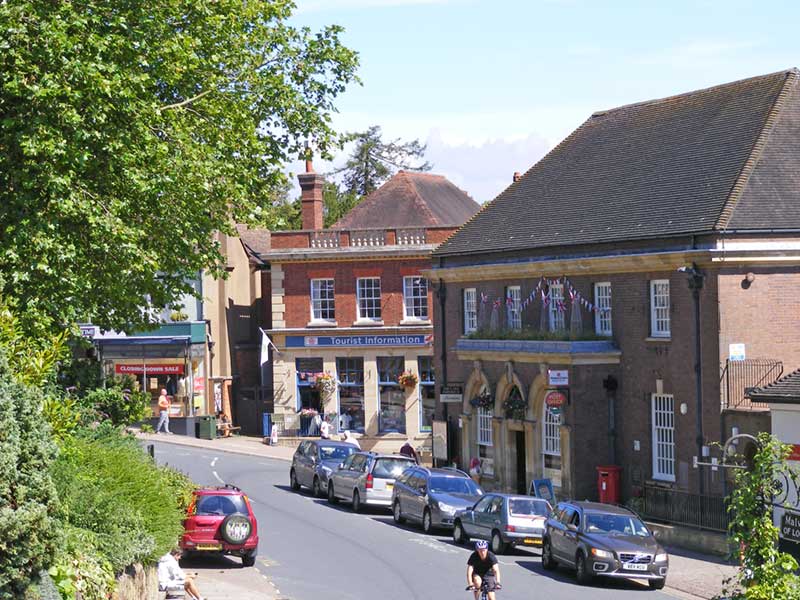
Great Malvern Post Office Kelly's directories listed the Postal Service following the description of the town, emphasising that the postal service was central to the life of the town. The 1908 entry for Great Malvern reads, Post, MO & TO, SB & A&I, stamp office; postmaster William Stone.
MO Money Order TO Telegraph Office SB Savings Bank A&I Annuity and Insurance Kelly's 1918 entry reads Post, MO, T & Telephone express delivery service, Church St, postmaster JH Boulton. (The photo above shows the side of Great Malvern post office. Below and entered through the green door there was a Conservative Club which closed about 2005. We think this side of the building might have been part of the original piano shop.) The Kelly's directory entry of 1918 tells us that the telephone service had reached Malvern, but, as you will read below, there were some telephones in Malvern as early as 1902. The Telephone Express Delivery Service mentioned above enabled a phone call to be put through to a telegraph office. At that or another receiving telegraph office the short message would be printed or written onto a telegram form and delivered by a postman or messenger. Very similar to sending a telegram from a post office, but allowing the message now to be sent from homes and businesses with a phone. Delivery of telegrams to homes within 3 miles of the post office was free, but further away the recipient had to pay. The novel 'Lark Rise to Candleford' has good descriptions of a village post office in the 1890s, especially in the chapter 'On Her Majesty's Service' from 'Over to Candleford' where Laura goes to work for Miss Dorcas Lane. As time went on, the UK government acted to bring all telecommunications under its control through The General Post Office. Once it was common to see telegraph poles with crossbars carrying a number of lines on white insulators running alongside roads, but nowadays most cables are underground.
In the 1980s the Thatcher government split the General Post Office into Royal Mail and British Telecom and privatised BT in 1984. At the same time the telecom market was opened up to greater competition, which enabled new products to be developed and introduced at a faster rate. Post Office Ltd is now a government owned company, separate from Royal Mail. Governments have been closing sub-post offices to cut costs which has been unpopular in small villages where there is little or no alternative, and new services are being introduced as the post office modernises. Some post offices are advertised for sale which suggests the post office is becoming a franchised activity.
In the town of Worcester the large old Post Office in Foregate Street has closed and moved to a counter on the top floor of WH Smith in the High Street. It seems to us that access for disabled people and mothers with push-chairs is not as easy as it once was. Since we first drafted this article the government has privatised Royal Mail; its name had been changed to Consignia plc which proved highly unpopular so the name was changed back to Royal Mail. The business parcel service now has a lot of competition from private carriers, whereas the Post Office and Royal Mail seem to have the monopoly as far as private individuals are concerned.
Royal Mail van in Southlea car park The telegraph and telegramsAbout 150 years ago before the invention of electricity, long distance communications took the form of hand written messages carried by a mail-coach pulled by horses. Letters going abroad had to be sent by ship. There were of course crude semaphore systems such as smoke signals, jungle drums, flags and lights, but these were not suitable for business use. A famous semaphore system consisted of a series of towers to relay coded messages between Portsmouth and the Admiralty in London in the 1800s. Experiments with electricity and magnetism by Charles Wheatstone and others led to the development of the electric telegraph which began to come into general use from about 1860. It was an invention that changed the world.
Click here to listen to sample of morse code The photo above shows a telegraph key of WWII vintage which was part of a British army field signal lamp equipment (a lot of interesting stuff could be purchased from government surplus shops in the 1950s). Many variants of the morse key were produced which enabled skilled operators to send at a faster rate. Over time various codes and methods of sending and recording the received signal were devised. One of these was the ABC telegraph machine, as used by Laura in 'Lark Rise to Candelford', where you will find a vivid description of the apparatus and how it was operated. The Telegraph probably reached Malvern in the late 1870s. Littlebury's directory of Worcester and District 1879 mentions the nearest Telegraph Office to Madresfield being in Malvern Link and the nearest Telegraph Office to Guarlford being in Malvern. The 1881 and later censuses begin to record occupations such as post office sorting clerk and telegraphist which had not been seen locally before. In 1881 the Great Malvern post and telegraph office was on the Worcester Road opposite the Foley Hotel (now J B Wetherspoon). By 1908 there were telegraph offices in the sub post offices at Upper Wyche, Barnards Green, Oxford Place (near Link Top), Malvern Link, Madresfield and Hanley Castle. These were located in small shops and the shop owner was the sub-postmaster. The development of the Telegraph from 1860 onwards enabled short text messages known as telegrams (similar to mobile phone text messages) to be sent more speedily than by letter post. The message received at the telegraph office was often delivered to the recipient by a messenger boy on a bicycle. You can now be reading a text message within seconds of it being sent, but in those days a telegram might take an hour or so to be sent and delivered. The UK Telegraph Act of 1868 and subsequent Acts enabled the government to buy out the private operators and put the Telegraph and later, Telephone Services, under the control of the State-owned Post Office. In the 1940s telegram messages were printed onto a continuous reel of paper tape which was then torn into strips and gummed to a telegram form which was then delivered by hand. In some cases the message was hand written. The Cable and Wireless company with its headquarters at Electra House, Victoria Embankment London WC2, accepted telegrams for all parts of the world, and ships at sea. 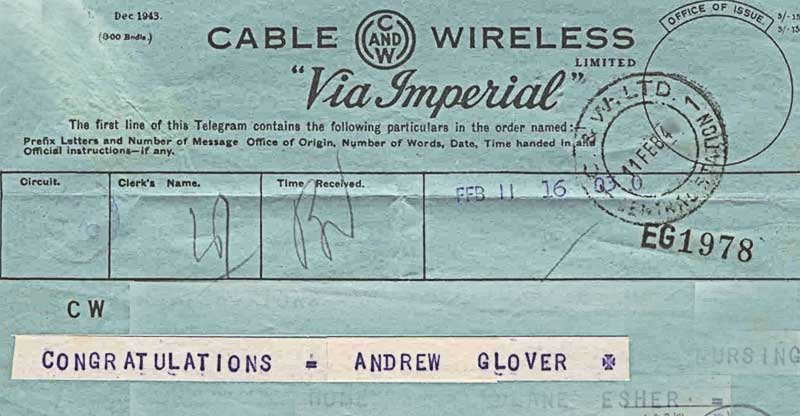
The use of telegrams declined rapidly after 1950 and the service was discontinued in 1977. The teleprinterDevelopment of the telegraph led to the teleprinter which enabled messages (including telegrams) to be keyed in using a typewriter style keyboard and messages to be printed onto a roll of paper at the receiving end.
The start bit told the receiving teleprinter to expect character pulses. The character pulses operated electromagnets using timing from the electric motor and during the stop period the receiving teleprinter reset ready to expect the next character. This enabled small differences of timing to be tolerated as during the stop bit the slower machine could catch up. The teleprinter was noisy and operated at about 50 bits per second (or bauds) giving a speed of about 6 characters per second (equivalent to 66 words per minute). Compare this to the Internet which now offers customers in the home speeds between 2 to 50 Mb per second, up to a million times faster. Before the advent of satellite communications, long distance circuits were established over HF radio and this was known as RTTY. This often incorporated an Automatic Request for Repeat (ARQ) mechanism to cope with fading. Early machines used different codes, but by about the 1930s each character was encoded using 5 unit International Telegraph Alphabet number 2 (ITA2) which provided only 32 combinations. This was not enough for the alphabet, numbers and punctuation, and so letter and figure shift characters told the teleprinter to interpret the code either as capital letters or numbers. In the 1960s teleprinters such as the Creed 444 and Siemens T100 were widely used by large companies and newspaper groups, but very few are in use nowadays. Partly this was due to the introduction of cheaper facsimile machines in the 1970s. Teleprinters were often operated on point to point circuits and through manual exchanges, but circa 1950 the Post Office created an automatically switched teleprinter network using Strowger exchanges called Telex. The teleprinter embodied a tape punch and reader and was connected to an interface box with a telephone dial. First the message would be typed onto punched five hole paper tape, and then the circuit would be established by dialling the number. If the line was not busy and the correct who are you (WRU) response was obtained, the message would be transmitted by passing the paper tape through the tape sender. The chief developer of the teleprinter in the UK was Canadian born engineer Frederick George Creed (1871 - 1957), who with Danish telegraph engineer Harald Bille founded Creed and Company which was later taken over by IT&T about 1927. Small numbers of machines were being used as early as 1912 by newspaper organisations, but teleprinters were never used in the home. The telephone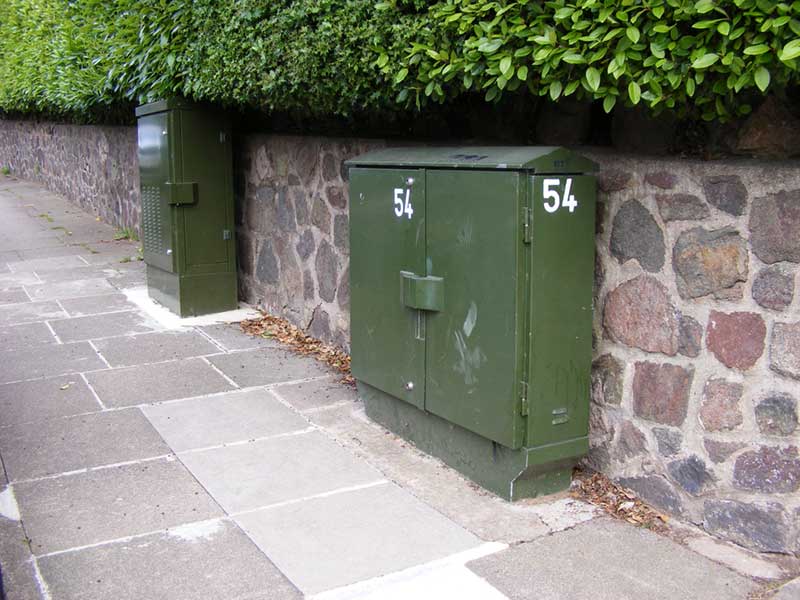
Scottish born scientist Alexander Graham Bell (1847 - 1922) is credited with the first practical transmission of voice signals along a pair of wires. Very soon after, the first telephone exchange was opened in London in 1878. The British government decided the telephone companies came under their Telegraph Act and they had to buy a 31 year licence to operate from the Post Office. However, it was not until some 22 years later that the telephone came to Malvern and the Worcester area. The first evidence of this is the National Telephone Company Ltd telephone directory for the Midlands of 1902 when there were about 78 subscribers in Malvern. The Police station was Malvern 1, and Earl Beauchamp at Madresfield Court was Malvern 24. Mainly the subscribers were businesses and professional people such as doctors and surgeons. There was a public call office in Church Street and the postal services were in Worcester Road. It seems likely that in 1902 the Malvern Telephone Exchange was in the premises which had been a piano shop on the corner of Church Street and Abbey Road. In 1911 the licences were not renewed and the telephone companies became Post Office Telephones as evidenced by the telephone directory of 1912. It seems likely that the Post Office in Worcester Road then colocated at the top of Church Street, though it could have colocated earler. (We wondered whether the first telephone exchange had been in The Exchange building on the corner of Graham Road and Church Street (see photo below). Indeed the 1911 Census people have translated The Exchange as Telepone Buildings, but we have found no evidence of that. If you know who built The Exchange, when and why we would be interested to hear from you.) 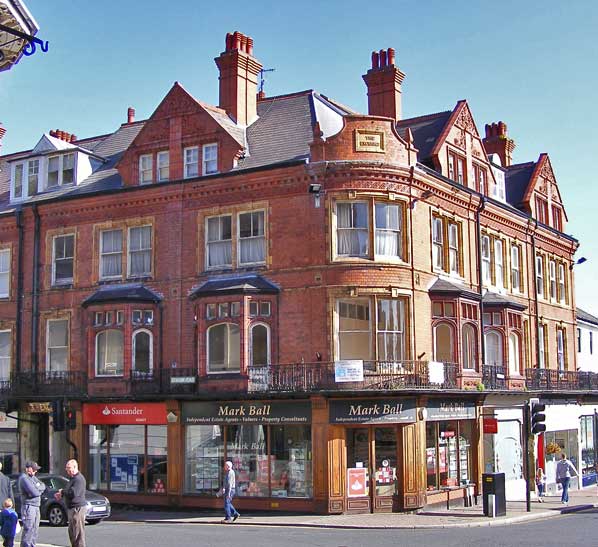
The Exchange building About 1935 the Great Malvern Post Office was extended and rebuilt by demolishing the vicarage next door forming the building we see today..
The building was a large private house named Abbotsfield, now number 14 Abbey Road on the south side of the Baptist church. See photo of Abbotsfield below, taken in 2013. In 1861 Abbotsfield had been the home of 'water cure' Doctor James Loftus Marsden whose hydrotherapy practice was at Hardwicke House and Elmsdale furthe down Abbey Road. 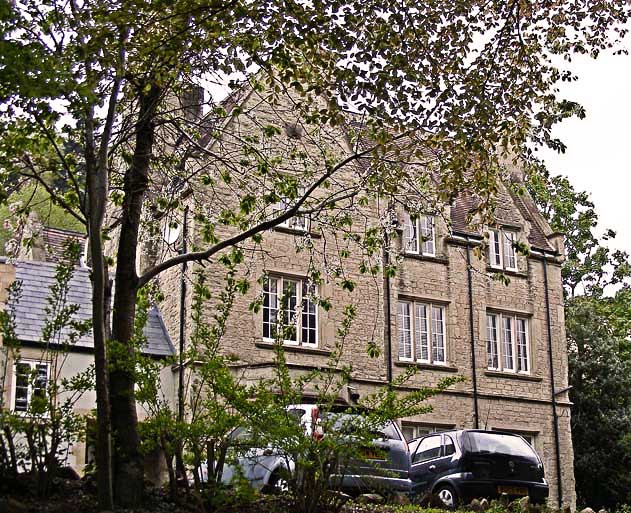
Abbotsfield The telephone Exchange is now in Abbey Road South, and it is assumed that Malvern UDC offered the remainder of the land to the GPO when Southlea school's playing field was taken to build the car park opposite the Splash leisure centre. The automatic exchange was installed in the 1960s. 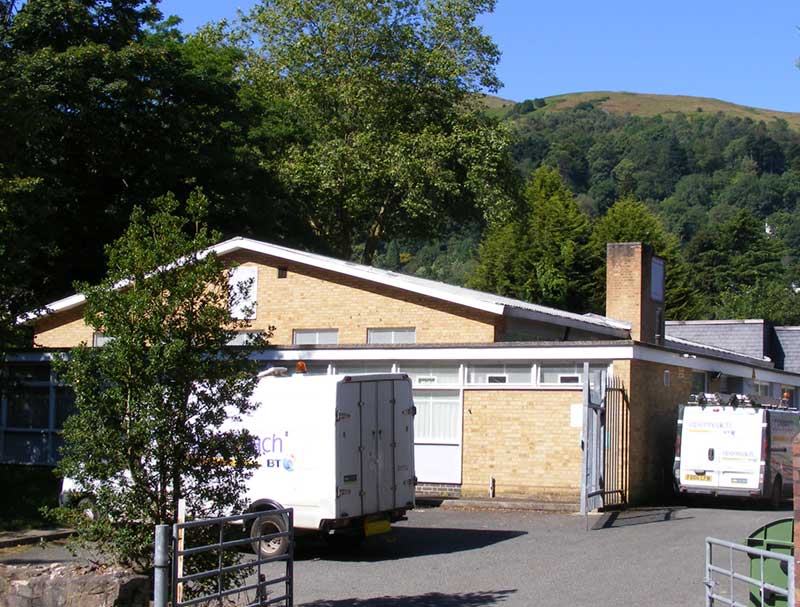
Telephone exchange in Albert Road South In the 1980s and 1990s new digital System X computer controlled exchanges were introduced, which were much more reliable and converted the phone's analogue signal into Pulse Code Modulation, enabling better voice quality on long distance calls. Transmission of digitised voice and video calls over the Internet is now possible, for example using the Skype service, and it will be interesting to see what form the replacement for System X will take. The mobile phoneBT Cellnet, one of the first mobile phone companies in the UK, was formed in 1985, following introduction of the first European mobile phone network in 1981. In 2002 Cellnet became O2. In the 1980s it seemed science fiction that mobile phones would spread so widely in society. The first phones were expensive and bulky and reception was patchy. Some 25 years later mobile phones are tiny, incorporate digital technology, a camera, the ability to connect to the internet and some can even receive geolocation signals - and nearly everyone has one. Mobile phones are a boon to tradesmen and other people on the move and to people who live in rented accommodation and do not have a landline. Data communications and the InternetIn the 1970s computing took the form of large main-frame computers mounted in racks or cabinets in large air conditioned rooms, mostly running batch jobs. These computers had a fraction of the power of modern 'Laptops'. Remote users were first able to connect using a terminal such as a teletype and modem over either dial-up or dedicated telephone circuits. The 'teletype' was a noisy form of teleprinter that used a seven bit code (plus a parity bit making eight bits in all) for data communications. This enabled the use of both upper and lower case letters, control characters and additional punctuation. The code was called International Telegraph Alphabet number five or ITA 5. The American implementation was called the American Standard Code for Information Interchange or ASCII. Because telephone lines at that time could only carry audio signals of 3KHz bandwidth, the modem was used to convert binary digits to audio tones and vice versa. Typically an early modem provided full duplex (two way) communications at either 110 bits per sec for the teletype or up to 300 bits per sec for computer to computer communications. A new form of data communications began to be developed in the 1970s called Packet Switching. The US Applied Research Projects Agency developed the experimental ARPANET from which the Internet evolved. The 1970s saw rapid change in the computer industry. The Digital Equipment Corporation (DEC) introduced the more affordable PDP 11 16 bit minicomputer used in many laboratories while Intel produced the first 8 bit microprocessor chips. In the 1980s Clive Sinclair produced the first home microcomputer the ZX81 followed by the Sinclair Spectrum. There were many competitors such as the Commodore C64 and Plus/4, the BBC Acorn (used in schools) and Amstrad home computers. The Commodore Plus/4 introduced in 1984 had 64K of RAM and included a simple word processor and Basic interpreter. It was fun to use for games, typing and developing Basic programs. Nowadays, for the same money, taking into account inflation, you can buy a Laptop PC which is immensely more powerful.
About 1984 IBM launched the desktop Personal Computer or PC for business use. There followed a long deliberation of the merits of centralised versus distributed computing. The trend today seems to be a move back towards large mainframes and dumb terminals which in newspeak is known as Cloud Computing. All these developments have been underpinned by rapid advances in semiconductor design and manufacture, enabling more functions and memory to be carried on a chip, allied to advances in the design of small hard disks, the development of digital telephone exchanges and replacement of the copper lines by fibre optic cable. In the 1980s, 8 inch floppy disks were replaced by 5 and 1/4 inch disks and then by 3.5 inch disks in a plastic case. In the early years of the 21st century these largely gave way to the CD and later the DVD, which in turn are now largely superceded by the USB memory stick currently offering a capacity of 32 GB or more. It was not until about 2000 that the Internet began spreading into homes in the UK. Before that concerns about the cost of BT telephone access limited take up. Initially connection to the internet was by dial-up access using a modem. Modems were advertised to operate at up to 56 Kbit/sec which meant that in practice it could take a long time to download photos, music and software upgrades.
The later BT Home Hum router enabled PCs and Laptops also to be connected using a Wirelss radio/data link which in turn enabled a number of users or devices, such as printers, to share an Internet connection. We are about two miles from the Great Malvern exchange and obtained a typical download speed of about 2 Mbit/sec and an upload speed of one quarter of that. Because the Broadband signal is in a different frequency band telephone calls can be made in parallel with use of the Internet, separation of the signals being achieved by the filter.
It is only cost effective to do this if there are a lot of homes close to the cabinet and in consequence rural areas tend to be poorly served. See photo of Fibre Street Cabinet (left). If the cabinet has been activated you will hear a whirring noise from cooling fans, and there will be a sticker on the front. Note that the effective speed achieved will depend on a number of factors - your computer, wiring within your home, type of wireless connection, the traffic load from other users on the network, and the speed of the computer from which you are downloading information. The introduction of wireless technology to connect devices to the local router has enabled groups of users such as families, students, and lodgers to share a connection, and people on the move to access the Internet at, for example, hotels and airports. Nowadays it is also possible to connect to the Internet using a data enabled mobile phone. Security The Internet has become a wonderful place to find and share information and to shop, but remember that anything you post will most likely remain in the public domain for your lifetime and possibly after. Criminals send out Phishing emails inviting you to click on a link and confirm your security details, essentially inviting you to send your login information so they either can steal from your bank account or make purchases from on-ine stores using your details. Don't click links in emails unless you are sure who they are from. Bogus email attachments and software downloads could potentially install trojans such as key loggers sending what you type to another computer. Firewall and anti virus software and regularly installing operating system updates can help prevent this. Security of wireless routers needs to be properly set up to prevent someone either outside your home in a car or in an adjacent flat using your connection for nefarious purposes, or you could find the police calling and find it difficult to prove it was not you. The BBC has suggested it might be possible to hack into a computer using a Wireless Hot Spot. Whether that is so we don't know, but best be cautious if you have sensitive information to protect. In order to mitigate these issues some banks are now issuing customers with 'dongles' that create single use passwords for Internet banking. Fraudsters may also telephone you to collect personal details and even invite you to move your money to another account (theirs). Beware!
Bearer networksLandlines Steel or copper cable carried the telegraph and then telephone signals and the signal got weaker as the distance from the caller increased and only two people could be connected at any one time. Up to three homes could share a line on a manual exchange. The operator would give one ring to call the first house, two rings for the second and three for the third. Public call boxes were important when few people had phones. In the 1960s party (shared) lines were still in use due to shortage of lines. Automatic exchanges could ring the called party using the copper pair and earth. Phones were hardwired into a black junction box eg on a windowsill. It was found that a bandwidth of just 3 KHz was adequate for telephone calls and therefore hundreds of calls could be carried over a long distance coaxial cable using Frequency Division Multiplexers and amplifiers to offset signal losses. Now analogue speech is being converted to digital Pulse Code Modulation at the exchange so that Time Division Multiplexing and digital switching can be used. Since the 1980s fibre optic cable has been replacing copper as its wider bandwidth enables more telephone calls to be carried. The deployment of fibre optics was itself dependant on the invention of the laser and other opto-electronic devices to generate, modulate and sense the light beam. Undersea cables In the late nineteenth century, Great Britain was very active in laying submarine cables to support the activities of the empire abroad. Due to high signal losses these were only able to carry telegraph traffic until the 1950s when cables incorporating reliable valve repeaters were laid. Microwave links The development of radar in WWII led to the exploitation of microwave frequencies for radio communications and the microwave radio relay, which can be an alternative to landlines. Microwave links rely on line of sight between the sender and receiver so in fact have limited application for terrestrial application, due to the curvature of the earth, hills and buildings. The Post Office Tower in London is a national landmark and was a hub of the British microwave network. Marconi and ship to shore radio Marconi (1874 - 1937) was an Italian inventor and successful businessman who built upon the research of British scientists and Post Office engineers. He was the first to demonstrate that telegraph signals could be transmitted across the Atlantic by bouncing HF radio signals off the ionosphere. Marconi's developments led to the introduction of ship to shore wireless telegraphy, which was used to effect when the ship Titanic hit an iceberg in 1912. Radio telegraphy and voice Radio telegraphy, also known as Radioteletype (RTTY), refers to the connection of two teleprinters by a radio link, usually HF. The binary digital signal from the teleprinter is converted to audio tones by a modem using a process called Frequency Shift Keying (FSK). It was chiefly a technology of the 1950s and 1960s. Several teleprinter circuits can be multiplexed into an audio channel and long distance communication achieved as first demonstrated by Marconi. There are however major drawbacks. The first is that the transmission frequency has to be carefully chosen for the signal to be received at all. Secondly, there are fades to cope with, and thirdly there is very little spectrum for the number of users resulting in significant interference. Radio telegraphy has been largely made obsolete by satellite communications. Satellite communications The concept of using a satellite to relay wireless signals back to earth (instead of bouncing them off the ionosphere) was first proposed by Arthur C Clarke in a famous paper published in Wireless World in 1945. In the 1960s the rockets which had first been developed to carry intercontinental ballistic missiles were modified to launch satellites into orbit and carry men to the moon. The first commercial satellite Intelsat 1 known as Early Bird was launched in 1965. In those early days communications were mainly between large ground stations such as the Post Office Station at Goonhilly Down in Cornwall. Since those early days, satellites have become immensely more powerful due to improvements in solar panels, control systems and spot beam aerials. This has made possible video communications with mobile news vans, the satellite phones used by expeditions, global connections for the Internet, and cheap International phone calls. The Global Positioning System enables your position to be established by trangulation of the signals from three or more satellites, for example using a small Garmin or Tom Tom equipment bought from Halfords or Amazon. Not only that, but these equipments incorporating a digitised map and are so accurate they can tell you when to turn left or right while driving in town. Many motorists have now discarded their road map and rely only on their Satnav. Satnav is widely used by delivery drivers and also helps the emergency services speedily reach your location. Top of the range mobile phones now incorporate a Satnav capability so that you can be advised of shopping locations, petrol stations etc near your location. Mobile phone networks When you make a mobile call you probably give little thought to how the connection is made to the person at the other end. Your mobile phone is a marvel of technology. It contains a keyboard, display computer, battery, and radio transmitter receiver - all in the palm of our hand! When you make a call your phone talks to a base station. The UHF radio operates at short range and near line of sight, so many base stations are needed to cover the country. The base stations are connected by a circuit switched telephone network for voice and by a packet switched network for data, forming a cellular network. When you turn on your phone it talks to the nearest base station, so the network knows where to direct calls. If you phone overseas, your call will go through a satellite link introducing about half a second delay between you and the called person's reply. The tricky bit for the mobile network operator will be billing and setting tariffs for calls that may go through the networks of one or more companies and/or countries and a different mobile operator's radio base station at the far end. The reason overseas calls can be expensive is because everyone wants to take a cut. It is said mobile phones can rack up large bills by uploading data the user is unaware of, so check your settings and your tariff so you are in control and know exactly how much you are spending! You can connect your laptop to the Internet using a mobile phone or router box, but we currently don't know much about that. Local employeesWhile searching the Internet to discover when the utility services arrived in Malvern we came across the following people in the Barnards Green area of Malvern. PostmenIn 1881 Thomas Jones, postman, Madresfield Road, b 1846, Hanley Castle. Charles Perks, letter carrier, Pound Bank, b 1863, Great Malvern. In 1901 Thomas Fairfax, postman, Poolbrook, b 1867, Malvern. William Henry Shinn, post office clerk, Guarlford, b 1875, Worcester. Frank Percy Tate, assistant postmaster, Bellars Lane, b 1886, Marylebone, London. Leonard Bissendon, postman, Bellars Lane, b 1880, Malvern. Harry Lane, letter carrier, Barnards Green, b 1867, Malvern Wells. Gas menIn 1868 (source Kelly's directory of Worcestershire) Gasworks manager - James B McGregor. Secretary - Thomas Fletcher. In 1881 Philip Baldwin, innkeeper, Gas Tavern, b 1816, Great Malvern. In 1891 Joseph Brookes, gas stoker, Barnards Green, b 1857, Great Malvern. Philip Jones, gas stoker, Poolbrook, b 1856, Guarlford. John Edward Bedington, general fitter, Hall Green, b 1852, Malvern. Joseph Staunton, gasworks foreman, Bellars Lane, b 1863, Guarlford. John Tummey, gas stoker, Bellars Lane, b 1854, Worcester. Frank Henry Phillips, gas fitter, Barnards Green, b 1876, Henwick. Ernest Tomkins, gas fitter, Barnards Green, b 1883, Great Malvern. William Thomas Hunt, gas stoker, Yew Tree Cottage, Chance Lane, b 1872, Warwickshire. Urban district council officials in 1918(Source Kelly's directory of Wocestershire 1916) Gas manager and electrical engineer Sidney Trow Smith Surveyor, waterworks engineer and chief officer of fire brigade William Osborne Thorpe TelegraphistsStephen Wagstaff b1816 was a shopkeeper at the Cross Hands Post Office Hanley Castle, employing Lucy Osmond telegraphist in 1881. Frederick Dawborn b 1851, Stanmore, was chief clerk, Post Office, Church Terrace, Great Malvern in 1901. Thomas Wilks b 1854 North Malvern was a telegraphist living at 1 Grove Villas, Cemetery Road. Great Malvern. Annie Jones b 1866 Hanley Castle, was a telegraphist at Hanley Castle Post Office in 1881. William Henry Shinn b 1875 Worcester, was a sorting clerk and telegraphist living at Guarlford in 1911. William John Gibbs b 1885 Beer, Devon, was the son of a fisherman. In 1901 he was a post office clerk in Devon. In 1911 he was a Post Office sorting clerk and telegraphist of Albert Park Road, Malvern. Hilda Marie Maurice b 1887 Maesteg Glamorgan, was a GPO telegraphist (civil service) boarding at Dogger Bank in Church Street in 1911. Ida Mary Tarling b 1888 The Wyche, Malvern was a telegraphist and assistant to grocer and sub-postmaster at Hanley Castle Post Office in 1911. William Charles Gadd b 1893 Ross, Herefordshire was a telegraph clerk, Great Western Railway, living in Great Malvern in 1911. William Gerald Morris b 1893 Llanelly, Carmarthenshire, was a Post Office sorting clerk and telegraphist boarding with the Newell family in Richmond Road, Malvern Link. Telephone company employeesMaud Mary Clarke b 1889 Redditch, was a telephone operator, National Telephone Company, living in Pound Bank Road, Malvern in 1911. Elsie Mary New b 1892 Upton Upon Severn, was an Operator, National Telephone Company, living in Upton Upon Severn in 1911. John Joseph Pitt b 1880 Kidderminster was a telephone inspector living in Bellars Lane, Malvern in 1911. In WWI he joined the Royal Engineers (Signals) giving his trade as telephone linesman. Edward John Coates b 1866 Lincolnshire, was a telephone manager living in Malvern Link in 1911. His children had been born in South America. Harry John Dance b 1873 Norton Worcestershire, was a telephone labourer living in Malvern Wells in 1911. No telephone company employees were found in Malvern in 1901. Shop keepers at the Exchange BuildingsThe Exchange Building on the corner of Graham Road and Church Street was probably built about 1904. In 1881 the land was the site of Malvern Cottage owned by the Foley estate. On the other corners of the cross roads were the Gentlemans Club, a bank and the Beauchamp Hotel. William Davis, fishmonger, 3, Exchange Buildings, Graham Road (1911); prior to this William (known locally as Fishy Davis) had a shop in Church Street which he named 'Dogger Bank' (ref 1891 and 1901 census). William Tyte Hairdresser and Perfumier, 4 Exchange Buildings (1904). Clive Herbert, tobacconist, 5 Exchange Buildings, Graham Road (1904). Next door to 'The Exchange' in Church Street were Claremont and the Grosvenor House private hotel. Notably nearby in 1904 at 5, The Colonade, Grange Road, Malvern was, Santler C & Co. engineers, machinists, bicycle and tricycle manufacturers & electrical engineers. Santler built one of the earliest motor cars. Exanples of early telephone numbersIn the early years few people had telephones so the numbering system was very simple. Here are some examples of Malvern telephone numbers from the 1902 National Telephone Company directory. Number and subscriber 1 Police (this number still being used during WWII). 2 Sparkes A, ironmonger, Church Street. (Sparkes was demolished and the site occupied by Woolworths until replaced by the Iceland store. Source Brian Iles). 3 Unicorn Hotel. 4 Davis & Son, fish and game dealers, Church Street. 5 Imperial Hotel. 6 Ballard F, West Malvern. 8 Cridland and Walker, butcher. 9 Nott J, grocer, Church Street. 16 Post Office (postal facilities only). 19 Wilesmith and Son, timber merchants, Malvern Link. 24 Beauchamp Rt Hon Earl, Madresfield. 36 Malvern Urban District Council, Church Street. 56 Weir Dr Archibald, physician and surgeon, Malvern Link. 84 Coventry Cycle and Motor Co, Church Street. 0194 Nurses Home, Rockcliffe. Rockcliffe was close to where Miller Optiicians now stands in Church Street. Malvern Rural Cottage Hospital opened about 1868 at Redwood House, Hospital Bank. In 1902 there was no number for either the hospital, ambulance or fire service, but by 1940 the town boasted of having two motorised fire engines with 60 foot ladders. The 999 service was introduced about 1937. Worcester 1908Here are some more telephone numbers from Kelly's directory of Worcester and District dated 1908. 1X Carless V S, veterinary surgeon. 1Y Wood Joseph & Sons, (contractors), The Butts. 2 West Worcestershire Conservative Association. 8 Town clerk. 9 Fire Station, Copenhagen Street. 9 Police Station, Copenhagen Street. 27 Great Western Railway, goods station. Click here for a full transcription of the Malvern 1902 Telephone Directory ~~~~~~ The end ~~~~~~ References and books about Malvern1. Kelly's Directories of Worcestershire. 2. Kelly's Directory of Worcester and surrounds 1908 3. National Telephone Company Ltd directories of Worcester area 1902, 1904, 1906, and 1911. 4. Post Office Telephone directory of Worcester area 1912 5. Cenus of England and Wales 1871, 1881, 1891, 1901 and 1911. 6. Weaver Cora and Osborne Bruce, Aqua Malvernensis, a history and topography of the springs, spouts, fountains and wells of the Malverns, and the development of the public water supply, printed by Aldine Press, 1994. 7. Fare Malcolm, The Hanleys, a history of Hanley Castle and Hanley Swan, Logaston Press, 2010. 8. Iles Brian, Malvern Through Time, Amberley Publishing, 2009. 9. Iles Brian, The Malverns, Tempus Publishinbg, 2005. 10. Gill Holt, Malvern Voices, Wartime, An Oral History, Malvern Museum published 2003 by Aldine Press 11. Keith Smith, Around Malvern, The Chalford Publishing Company 1995. 12. Smith Brian S, A History of Malvern, Leicester University Press, 1964. 13. Covins Frederick, Malvern between the wars, a reminiscence, Book Production services, Malvern, 1981. 14. The Guarlford Story, published by the Guarlford History Group, , printed by Print Plus, Hereford, 2005. 15. Flora Thompson, Lark Rise to Candleford, (a trilogy incorprating Lark Rise, Over to Candleford and Candleford Green)), Penguin Books, 1973 edition. 16. Communication from Alan Hodges, March 2022. Shown below and closing this page is a photo of the back of a Cable and Wireless telegram form. 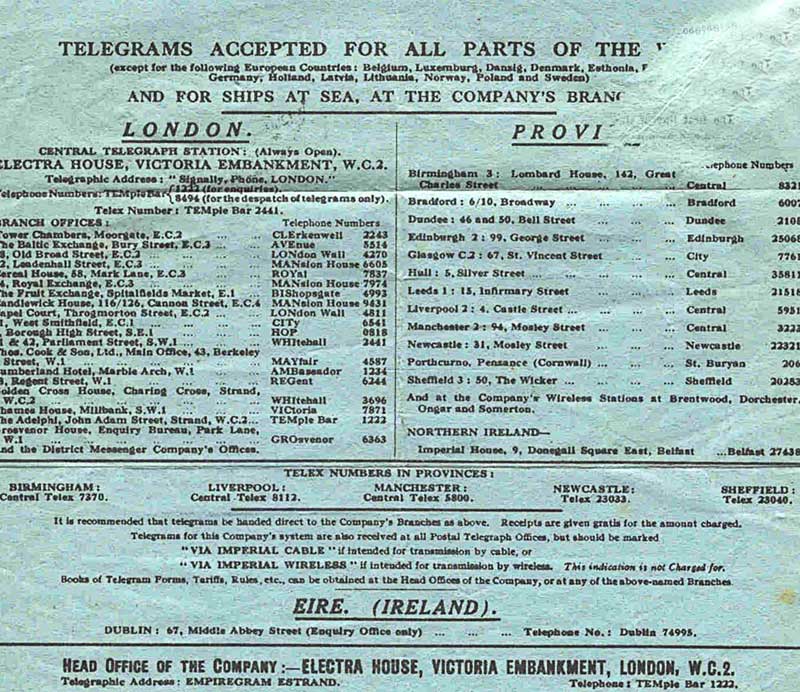
|
|
Last updated 17th March 2022 |
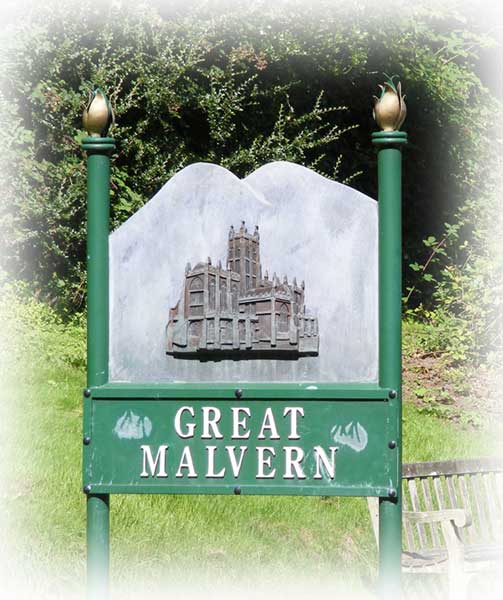 This is a story about the introduction of public
services, such as piped drinking water, gas, and electricity into the home, with special
reference to the development of these services over the last 150 years in
the town of Great Malvern in the county of Worcestershire, UK.
This is a story about the introduction of public
services, such as piped drinking water, gas, and electricity into the home, with special
reference to the development of these services over the last 150 years in
the town of Great Malvern in the county of Worcestershire, UK.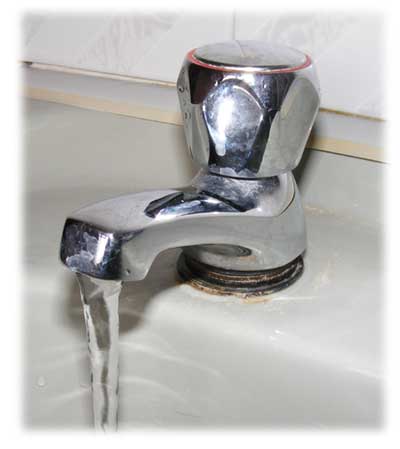 This is a brief
outline and for a fuller account you should read the book
This is a brief
outline and for a fuller account you should read the book 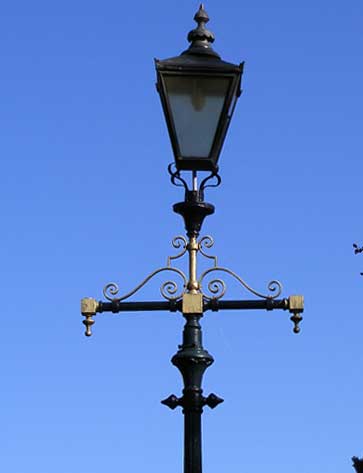
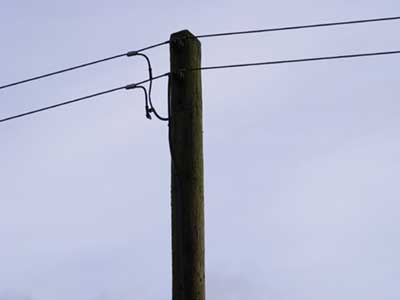 The principles of electromagnetic induction were discovered by the
English scientist
The principles of electromagnetic induction were discovered by the
English scientist 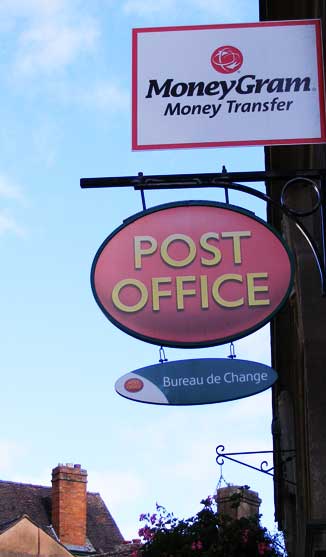 The postal service dates back to the reign of Charles II. Before
the penny post, letters had to be paid for by the recipient and the cost
depended on distance travelled.
The postal service dates back to the reign of Charles II. Before
the penny post, letters had to be paid for by the recipient and the cost
depended on distance travelled.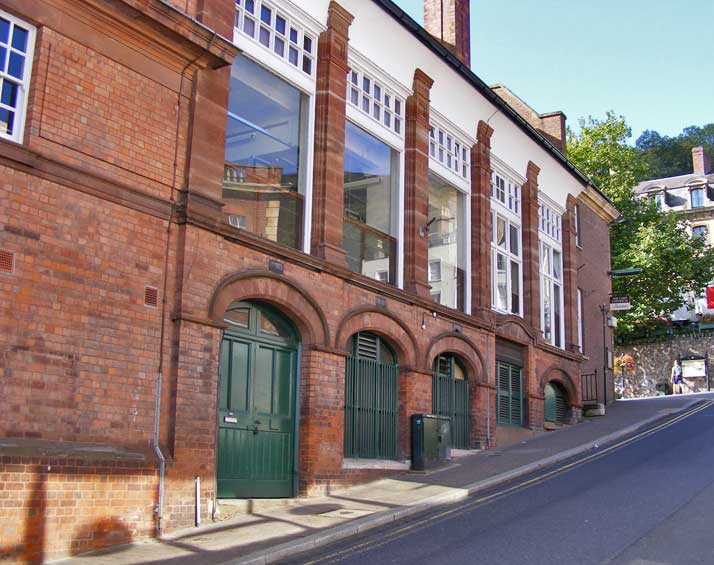 The initials stand for,
The initials stand for,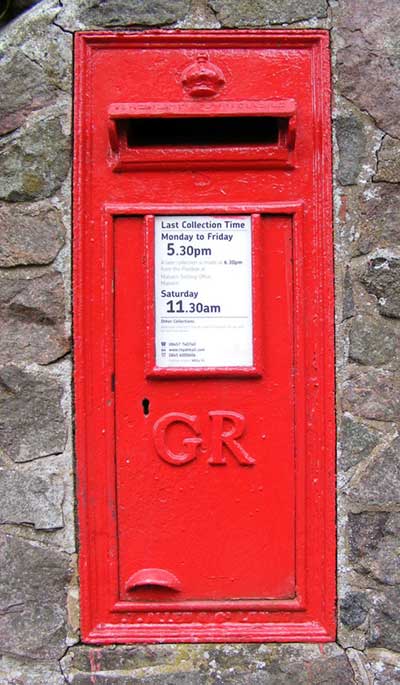 In the 1950s it was a common sight to see postmen in red Royal Mail vans
collecting and delivering letters, and engineers in green Post Office Telephone vans
maintaining lines and installing apparatus. The letter box shown left, in Albert Road,
probably dates from the reign of
George V.
In the 1950s it was a common sight to see postmen in red Royal Mail vans
collecting and delivering letters, and engineers in green Post Office Telephone vans
maintaining lines and installing apparatus. The letter box shown left, in Albert Road,
probably dates from the reign of
George V.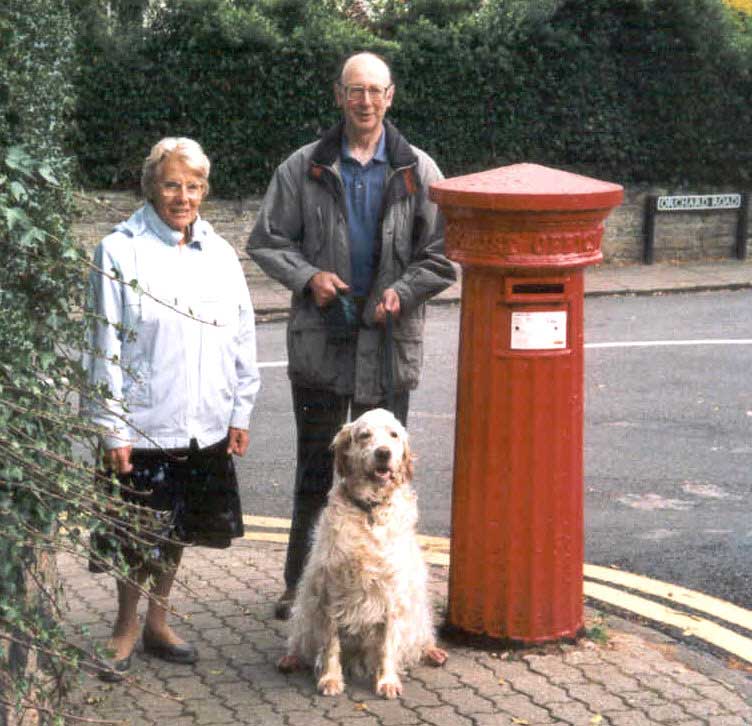 Despite
these advances, Great Malvern still has three Victorian letter boxes; see
example right. These are of the 1857 pattern produced in the Eagle Foundry
of Smith & Hawkes in Broad Street, Birmingham.
Despite
these advances, Great Malvern still has three Victorian letter boxes; see
example right. These are of the 1857 pattern produced in the Eagle Foundry
of Smith & Hawkes in Broad Street, Birmingham.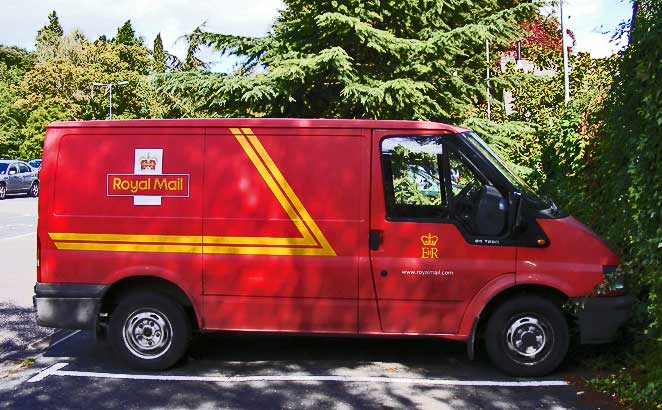
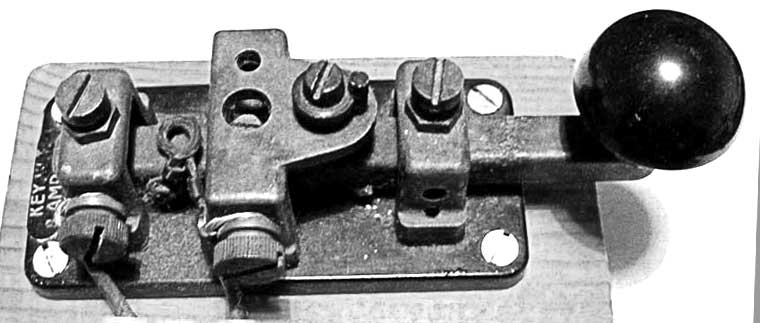 A voltage, hand keyed at the sending end of a pair of wires, could now be detected as
pulses of current at the receiving end so text could be transmitted as a patterns of
dots and dashes using a code such as that devised by
A voltage, hand keyed at the sending end of a pair of wires, could now be detected as
pulses of current at the receiving end so text could be transmitted as a patterns of
dots and dashes using a code such as that devised by 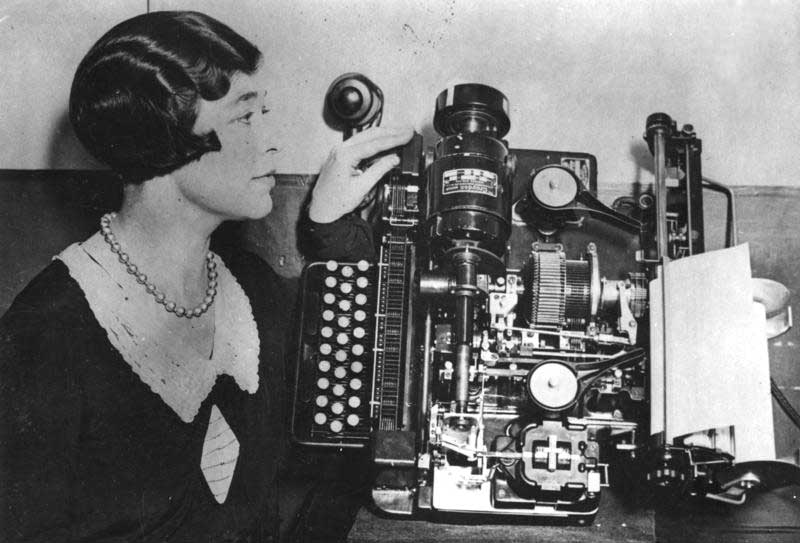 The teleprinter in its final form was driven by a synchronous
a.c. motor
and contained numerous cogs, cams and microswitches. A special feature of
the later machines was asynchronous transmission. A character was sent as a
start bit, followed by five data bits and one and a half stop bits.
The teleprinter in its final form was driven by a synchronous
a.c. motor
and contained numerous cogs, cams and microswitches. A special feature of
the later machines was asynchronous transmission. A character was sent as a
start bit, followed by five data bits and one and a half stop bits.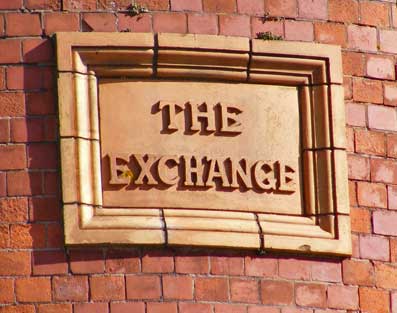 In 1956
the Malvern Electors and Rate-payers Association wrote to the GPO in Birmingham complaining of
the delays in setting up calls and asking for an automatic exchange. The GPO
replied that they had few complaints and had no plans to replace the manual
exchange for several years, although there was a property they had in mind
for a future automatic exchange, no longer required by a government
department.
In 1956
the Malvern Electors and Rate-payers Association wrote to the GPO in Birmingham complaining of
the delays in setting up calls and asking for an automatic exchange. The GPO
replied that they had few complaints and had no plans to replace the manual
exchange for several years, although there was a property they had in mind
for a future automatic exchange, no longer required by a government
department.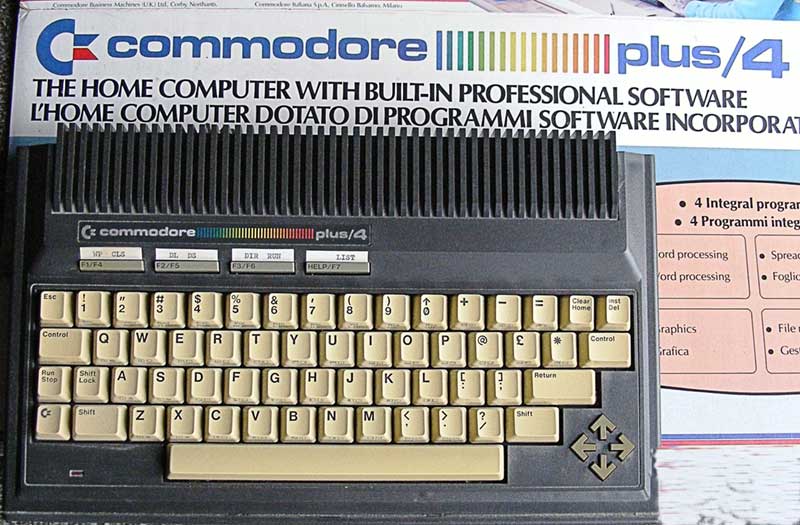
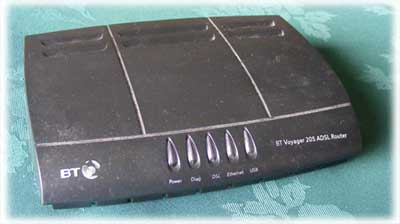 Circa 2007, BT began offering a Broadband Internet
connection which required a small filter with two outlet ports to be plugged
into the phone socket. The telephone was plugged into one port and a Router
into the other. The photo on the right shows a BT Voyager 205 router to
which the computer could be connected using either a USB or Ethernet cable.
Circa 2007, BT began offering a Broadband Internet
connection which required a small filter with two outlet ports to be plugged
into the phone socket. The telephone was plugged into one port and a Router
into the other. The photo on the right shows a BT Voyager 205 router to
which the computer could be connected using either a USB or Ethernet cable.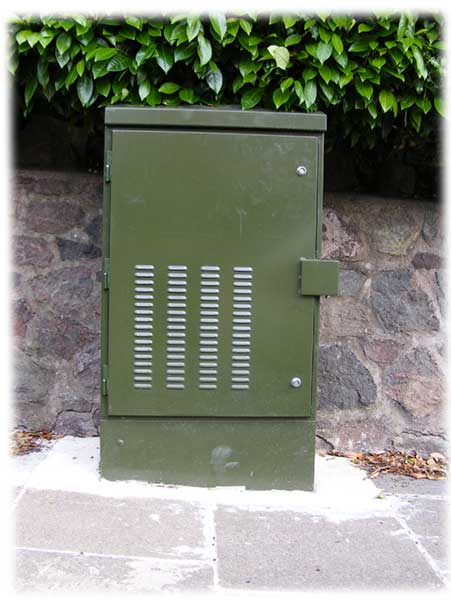 In
2012 BT started rolling out BT Infinity in Malvern. Essentially this
involves running fibre optic cable out from the exchange to a cabinet
containing a router where the data signal can be piggy backed onto the
copper pair running into the home. This can increase the line speed to
between 10 and 50 Mbit/sec depending on the distance of your home from the
cabinet.
In
2012 BT started rolling out BT Infinity in Malvern. Essentially this
involves running fibre optic cable out from the exchange to a cabinet
containing a router where the data signal can be piggy backed onto the
copper pair running into the home. This can increase the line speed to
between 10 and 50 Mbit/sec depending on the distance of your home from the
cabinet. This account is based on events
in our lifetime and local research; if you know more about how the utility
companies developed in Malvern please get in touch with the webmaster and share your knowledge
so that this page can be improved.
This account is based on events
in our lifetime and local research; if you know more about how the utility
companies developed in Malvern please get in touch with the webmaster and share your knowledge
so that this page can be improved.